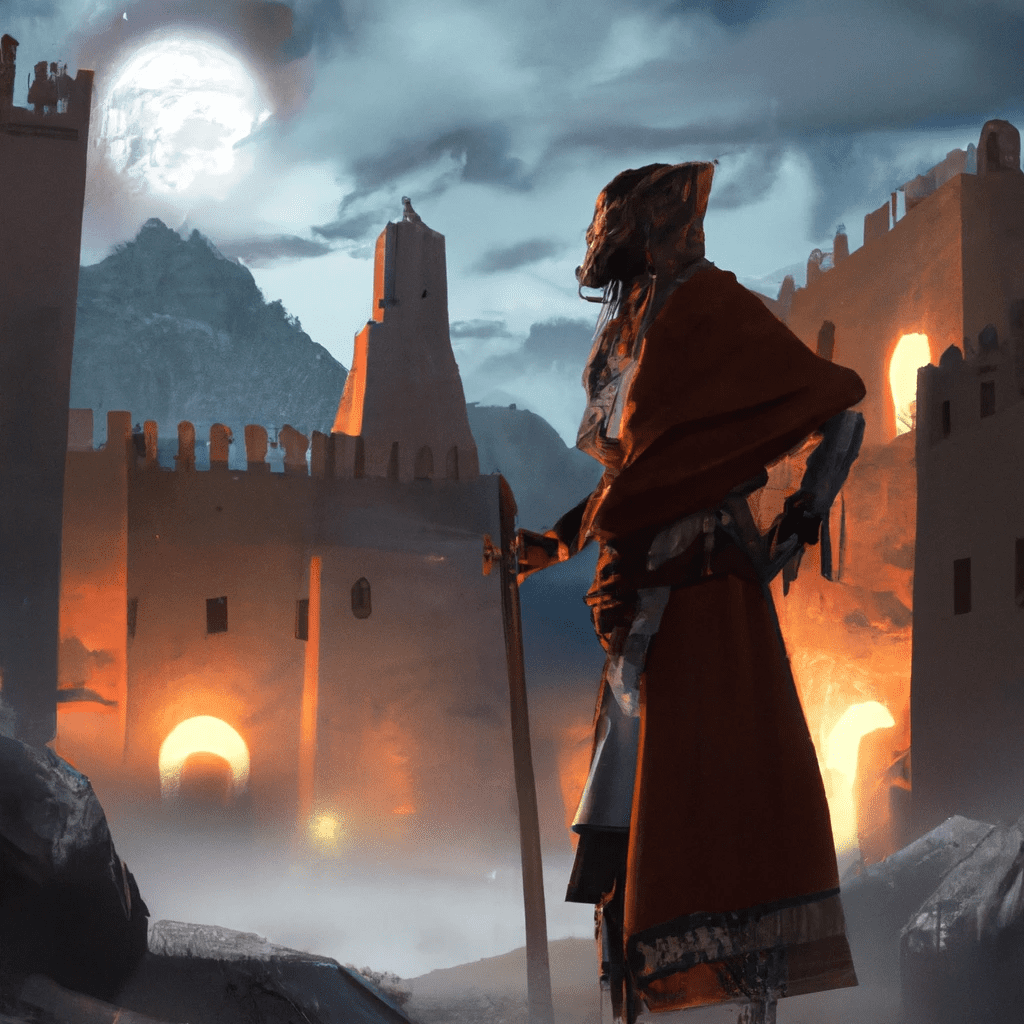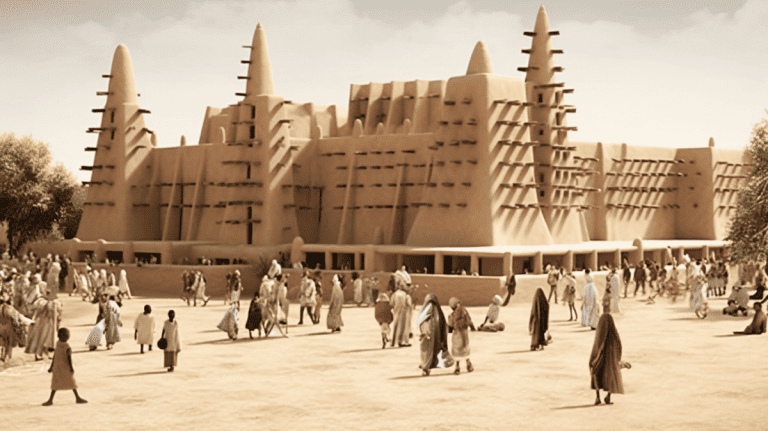The Kanem-Bornu Empire, a medieval African state in the Lake Chad region, was a hub of trade and Islamic culture. With Kanem as its foundation and Bornu as its later capital, the empire thrived from the 9th to 19th century, leaving a legacy of scholarship, governance, and economic prosperity.

Origins of the Kanem Bornu Empire
Deep within the annals of time lies the illustrious early history of the Kanem Bornu Empire, a treasure trove of knowledge brought to light by the discovery of the Royal Chronicle or Girgam, unearthed by the intrepid German explorer Heinrich Barth in 1851. It tells of a magnificent kingdom that thrived on the vibrant trade routes of Africa, a land of wonder and beauty that has captured the hearts and imaginations of scholars and historians alike. Though the empire may have fallen, its legacy still lives on, as evidenced by the Borno Emirate and Dikwa Emirate, proud successors that have stood the test of time and remain as traditional states in modern-day Nigeria. To this day, the Kanem Bornu Empire continues to inspire and intrigue, a testament to the resilience and spirit of remarkable people.
The Kanem Empire
The origins of the Kanem Empire can be traced back to the nomadic Kanembu people, who abandoned their wandering ways to build a great capital under the rule of the divine king Sef of Saif in 700 CE. The reign of his son, Dugu, saw the rise of the Duguwa dynasty and the magumi ruling establishment, a legacy that would endure for over a millennium.
The early penetration of Islam by North African traders, Berbers, and Arabs brought radical changes to the empire, resulting in the establishment of the Sefuwa dynasty under the noble Hummay in 1085. The new rulers brought Islamization to the court and state policies, but many people clung to traditional beliefs and practices.

Under the energetic and visionary leadership of Mai Dunama Dabbalemi of the Sayfawa dynasty, Kanem’s expansion reached new heights. He initiated diplomatic exchanges with sultans in North Africa and even facilitated pilgrimages to Mecca by establishing a special hostel in Cairo. But his reign also saw the destruction of the national Mune cult, which sparked widespread revolt culminating in the uprise of the Tubu and the Bulala. Although the former was eventually quenched, the latter persisted, leading to the retreat of the Sayfuwa from Kanem to Bornu around 1380.
The Bornu Empire
The Kanem Empire crumbled into chaos and disarray by the end of the 14th century, as a result of both internal conflicts and invasions from the Bulala people. The once-great empire was plagued by strife as seven different leaders took the throne between 1359 and 1383. Tragically, the Bulala invaders killed five of them, leaving the remaining two to wage war and battle for the throne. As a result of this bloody conflict, the people of Kanem were forced to flee to Bornu, where they faced even more struggles.

Bornu’s fate was plagued by hardship and turmoil as the Sayfawa dynasty struggled to maintain stability. For almost three-quarters of the 15th century, a succession of fifteen leaders held the throne, causing chaos and uncertainty. But Mai Ali Dunamami emerged as a beacon of hope for Bornu, uniting its people under his leadership. He built a powerful, fortified capital at Ngazargamu, the first permanent home for a Sayfawa mai in over a century. His success in revitalizing the Sayfawa dynasty led to the triumphant return of Njimi, the former capital of Kanem, under Mai Idris Katakarmabe’s rule in the early 16th century. Despite the triumph, the empire’s leaders continued to reside in Ngazargamu, where the land was more fertile and better suited for agriculture and livestock.
The Kanem Bornu Empire
The Sayfawa dynasty reached new heights of power and glory as it gained control over both Kanem and Bornu, creating the Kanem Bornu Empire. However, the true architect of this success was the visionary statesman Mai Idris Alwma, who implemented sweeping legal and administrative reforms based on Islamic law and his devout religious beliefs. Alwma’s passion for his faith was evident in the numerous mosques he commissioned and his pilgrimage to Mecca, where he established a hostel for pilgrims from his empire. The Sayfawa leader’s commitment to his people was unshakeable, and he surrounded himself with loyal and competent advisers, often recruiting educated slaves from noble homes. He required his top political figures to reside at court and forged lasting alliances through strategic marriages.
Under Alwma’s leadership, the Kanem Bornu Empire grew prosperous and formidable. The empire’s wealth was built on tribute, booty from conquests, sales of slaves, and participation in the lucrative trans-Saharan trade. Although the Chadian region lacked gold, it was situated along a vital trans-Saharan route. A string of well-spaced wells and oases connected Lake Chad to Fezzan, which in turn had easy access to North Africa and the Mediterranean Sea. The people of the Kanem Bornu Empire traded various products, including natron, cotton, kola nuts, ivory, ostrich feathers, perfume, wax, and hides, but the most lucrative export was human beings. The empire imported horses, salt, silks, glass, muskets, and copper, ensuring its continued prosperity and influence.

The Decline of the Kanem Bornu Empire
The rise and fall of the Kanem Bornu Empire was marked by power struggles, invasions, and decline. The empire, once strong and wealthy, crumbled under the weight of regional conflict and administrative disorganisation. The brilliance of Alwma, who brought legal and administrative reforms based on his religious beliefs, sustained the empire until the mid-17th century. But by the late 18th century, the empire’s rule had dwindled to the land of the Hausa, and the Fulani invasion from the west made significant inroads into Bornu.
In 1808, Fulani warriors seized the fortified capital of Ngazargamu, triggering a holy war against the irreligious Muslims of the area. Despite this, Muhammad al-Kanem, a non-Sayfawa warlord and Muslim scholar, challenged the Fulani advance, and eventually built a capital at Kukawa in 1814. This marked the end of one of the longest dynastic reigns in regional history, as the Sayfawa mais remained titular monarchs until 1846. Umar, Kanem’s son, eventually became king, but he lacked the vitality of his father and allowed the kingdom to be ruled by advisers.
The decline continued as a result of administrative disorganisation, regional particularism, and attacks from the militant Ouaddai Empire to the east. The once-great Kanem Bornu Empire was dealt its final blow in 1893, when Rabih az-Zubayr led an invading army from eastern Sudan and conquered Bornu. Though Rabih was eventually expelled, the state was absorbed by the British-ruled entity that eventually became known as Nigeria. From that point on, the remnants of the old kingdom were allowed to continue to exist in subjection to the various governments of the country as the Borno Emirate. The fall of Kanem Bornu Empire was a tragic end to an empire that had once been a centre of trade, scholarship, and power.
Related Posts
Sources
BlackPast. “Kanem-Bornu Empire (c. 9th century – 1900).” BlackPast, n.d. https://www.blackpast.org/global-african-history/places-global-african-history/empire-kanem-bornu-c-9th-century-1900/.
“Kanem-Bornu.” In Britannica. Accessed March 14, 2023. https://www.britannica.com/place/Kanem-Bornu.
“Bornu Empire.” In World Civilizations I. Accessed March 14, 2023. https://courses.lumenlearning.com/suny-hccc-worldcivilization/chapter/bornu-empire/.
Hiribarren, Vincent. A History of Borno: Trans-Saharan African Empire to Failing Nigerian State. Illustrated edition. C Hurst & Co Publishers Ltd, 2017.




